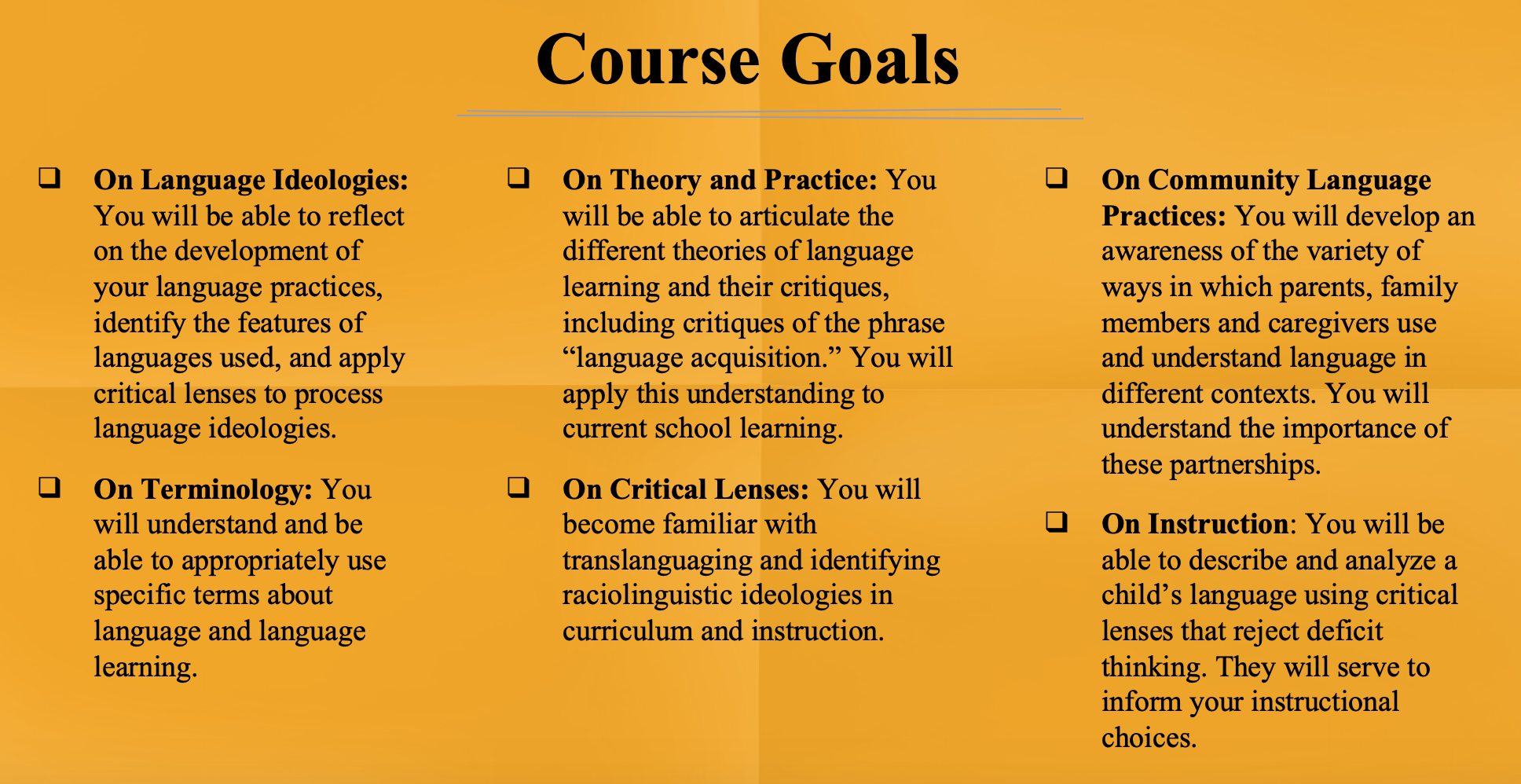I’ve been thinking a lot about my roles as teacher educator, daughter, mother, partner and friend during these times. I’ve listened to my body closely (especially as a new parent) and like many of you, my mind, spirit, and body are so exhausted with the weight of it all that it takes a whole lot to focus. And so, here’s a little bit of what I’ve been directing a lot of my energy towards lately: planning my graduate course in a teacher education program.
This summer (which actually started yesterday for me on the college calendar), I’m teaching a course titled on language learning in a linguistically diverse society. For the last few months, I’ve been engaged in conversations with colleagues about racial literacy, emergent bilingualism, creative and experimental spirit, and developmental variations at Bank Street Graduate School of Education. We’ve conducted inquiries on our syllabi and really asked the tough questions about how we were addressing (or not) some of these in our courses.
Is some of the work implied?
Are we being clear about our goals and addressing racial literacy?
There’s the conversation around intentionality and inquiry. For example, do we name critical lenses at the start or encourage/facilitate so that students come to these on their own (hopefully).
So here’s where I’m at with all of this. I’m guided by a sense of urgency, clarity and inspiration, some of which you’ll see here as I share my thought partners and co-instructors in this course! Hope you reach out if you’re on the same journey as we are in this course, whether on your own, with teachers, administrators or teacher-educators. Would love to learn of other texts, thought partners and ways that you center and validate the language practices of language-minoritized children in all learning spaces.
Course Description
The language practices of language-minoritized students are often deemed incorrect as measured against white, monolingual norms. This course reimagines language learning by moving beyond the study of language as a system (phonology, morphology, syntax, semantics, and discourse), and applying the critical lenses of raciolinguistic ideologies and translanguaging theory and pedagogy to the process of languaging. In the first part of the course, we’re focusing on processing language ideologies, identities and anti-Black linguistic racism. It’s really important to me that we address these matters at the start of the class, name them, and consider our roles/positionality in how we are moving towards a more equitable learning experience for all children. In the second part of the course, we will study how raciolinguistic ideologies take shape in curriculum and teaching and how we can disrupt these with translanguaging pedagogy and authentic assessments of bilingual and multilingual learners. We will study ways to integrate family and community literacies, the arts, and multimodal learning in the planning of instruction and nurturing relationships that validate linguistically diverse practices.
Sessions
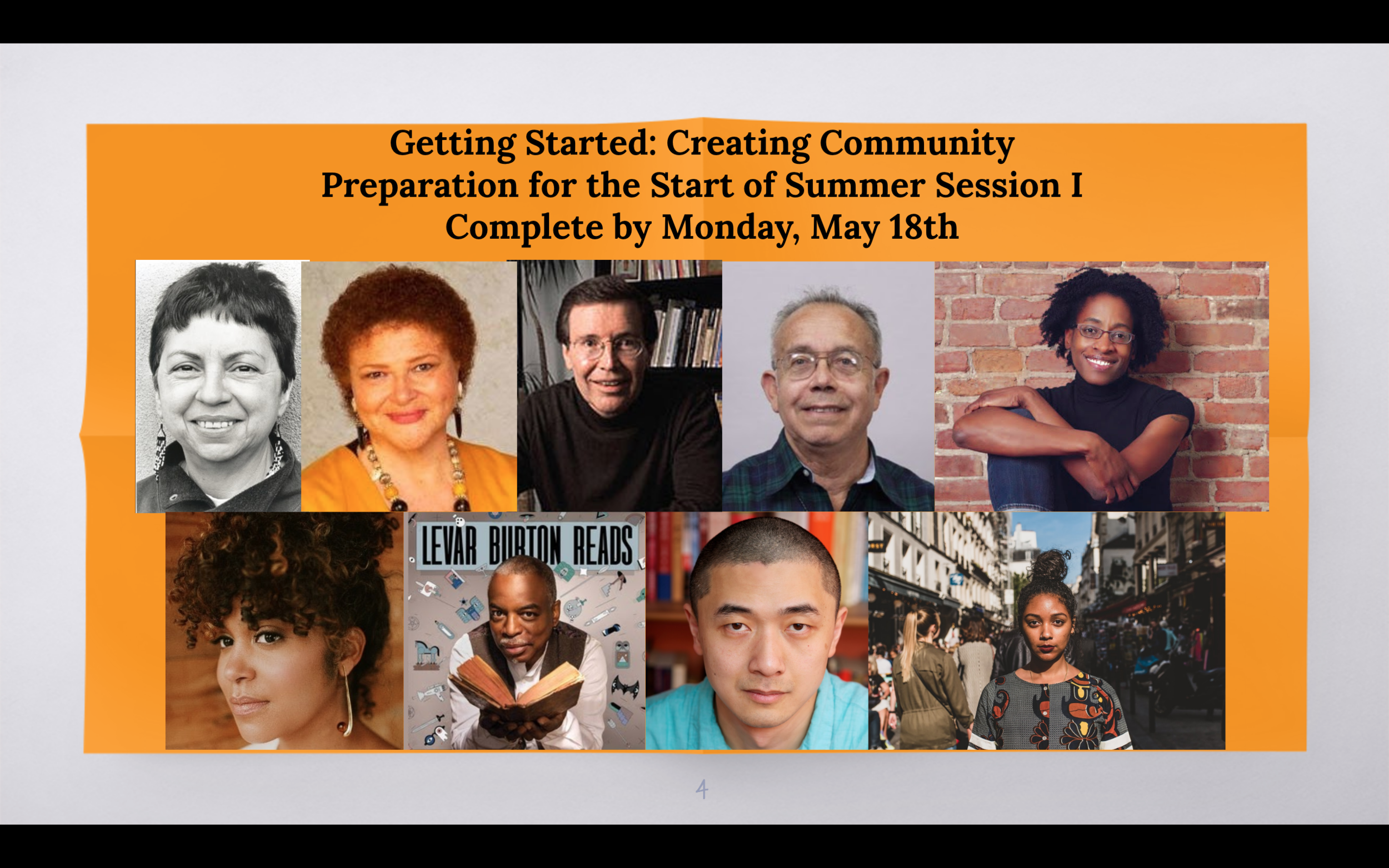
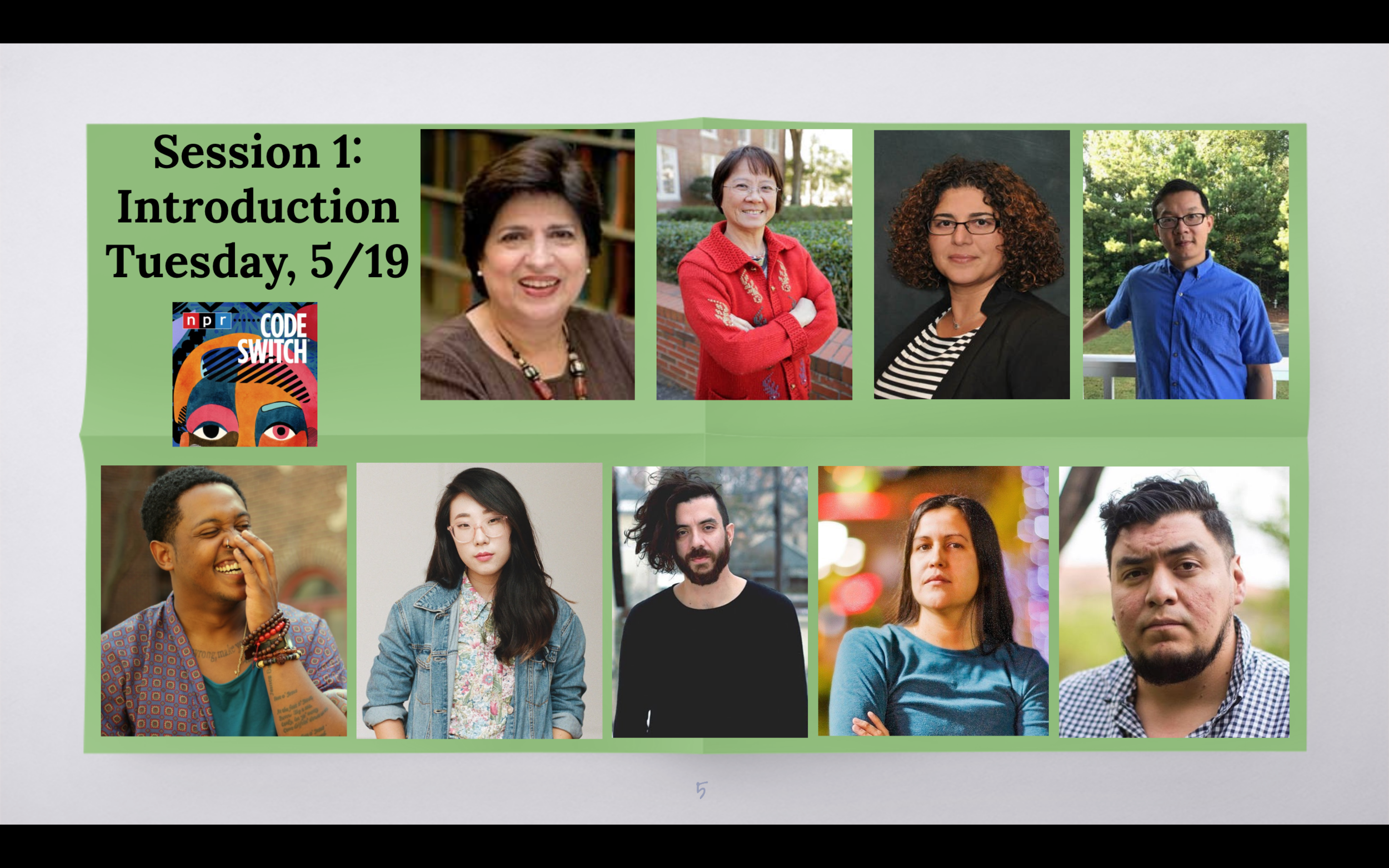

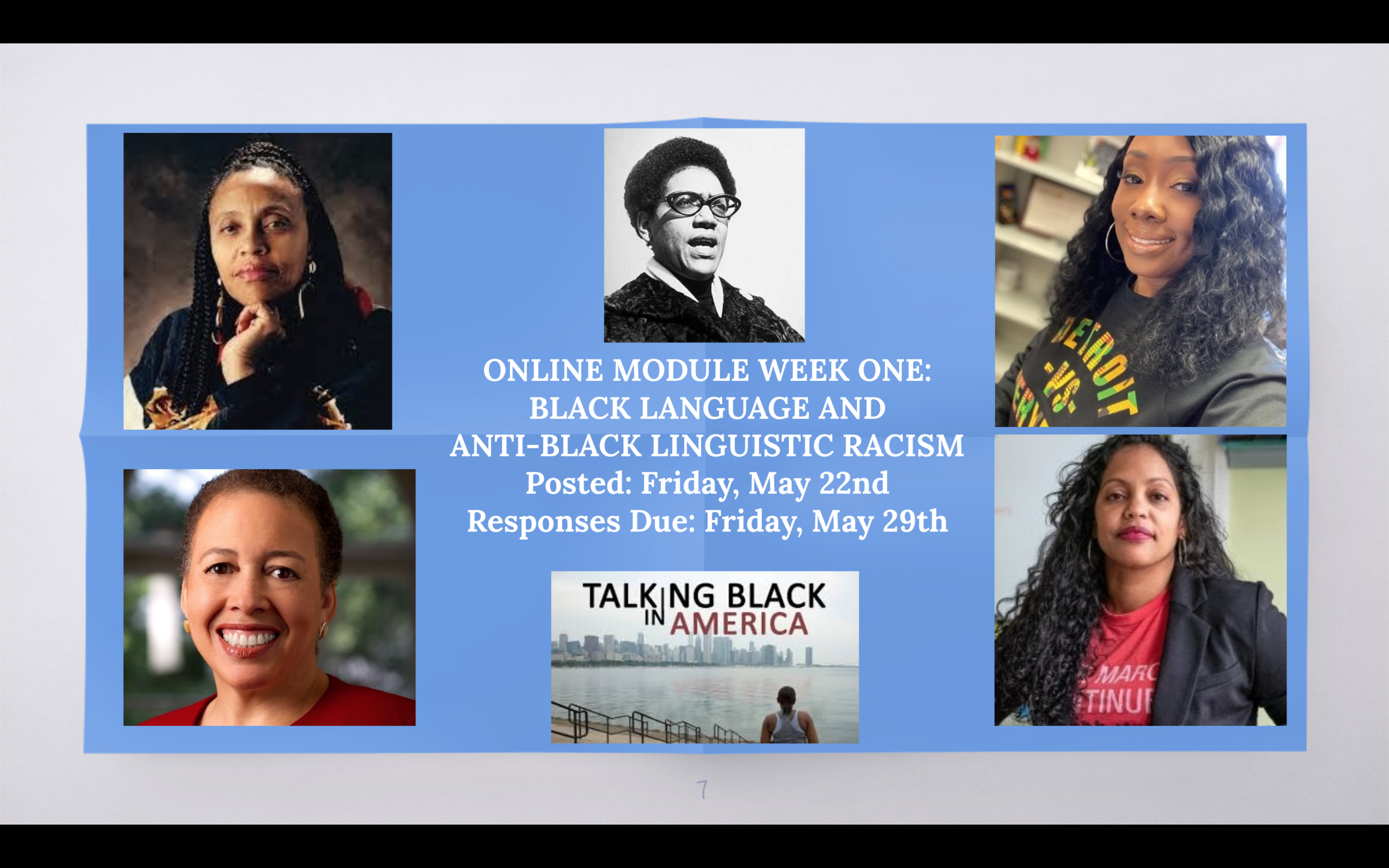


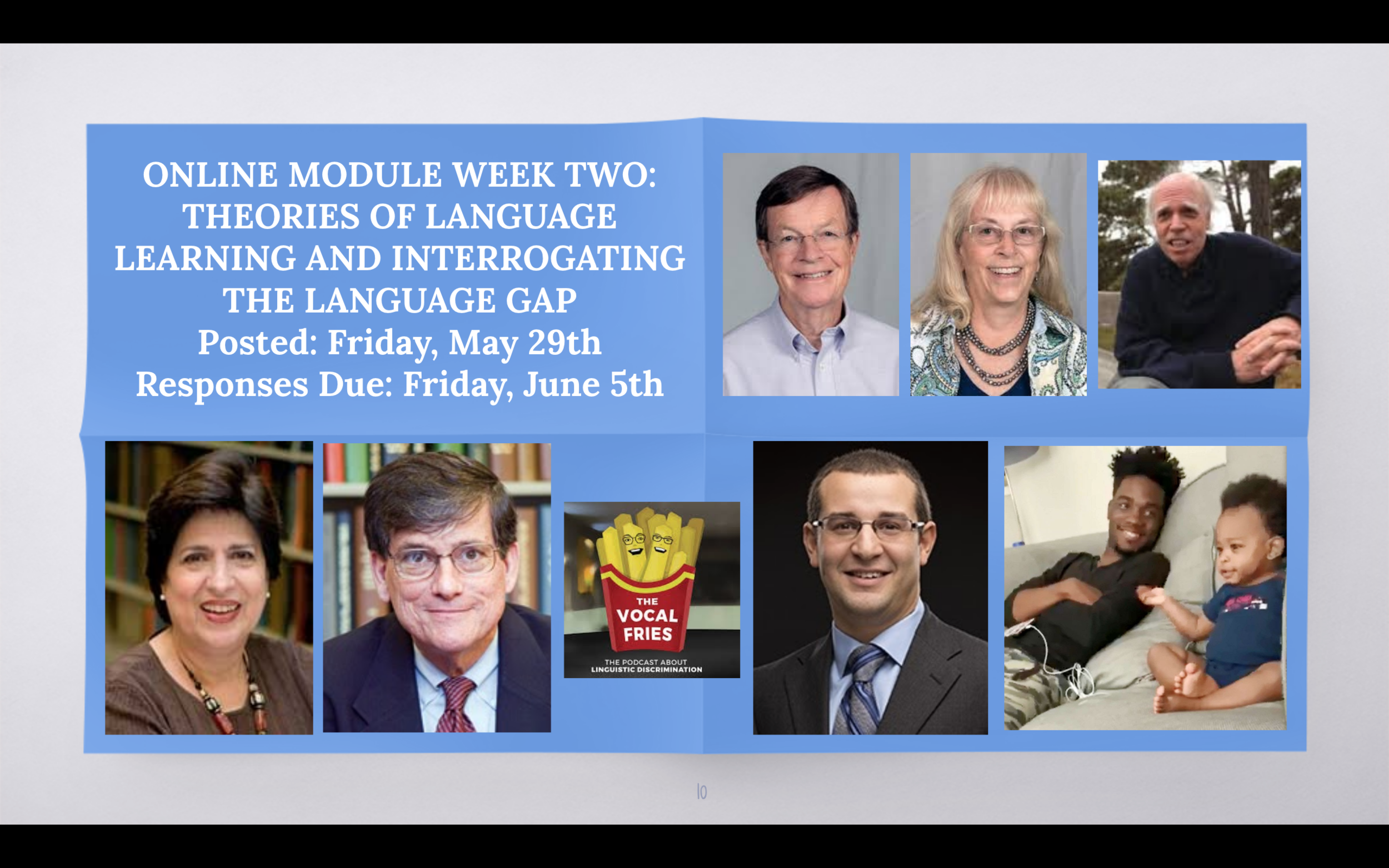
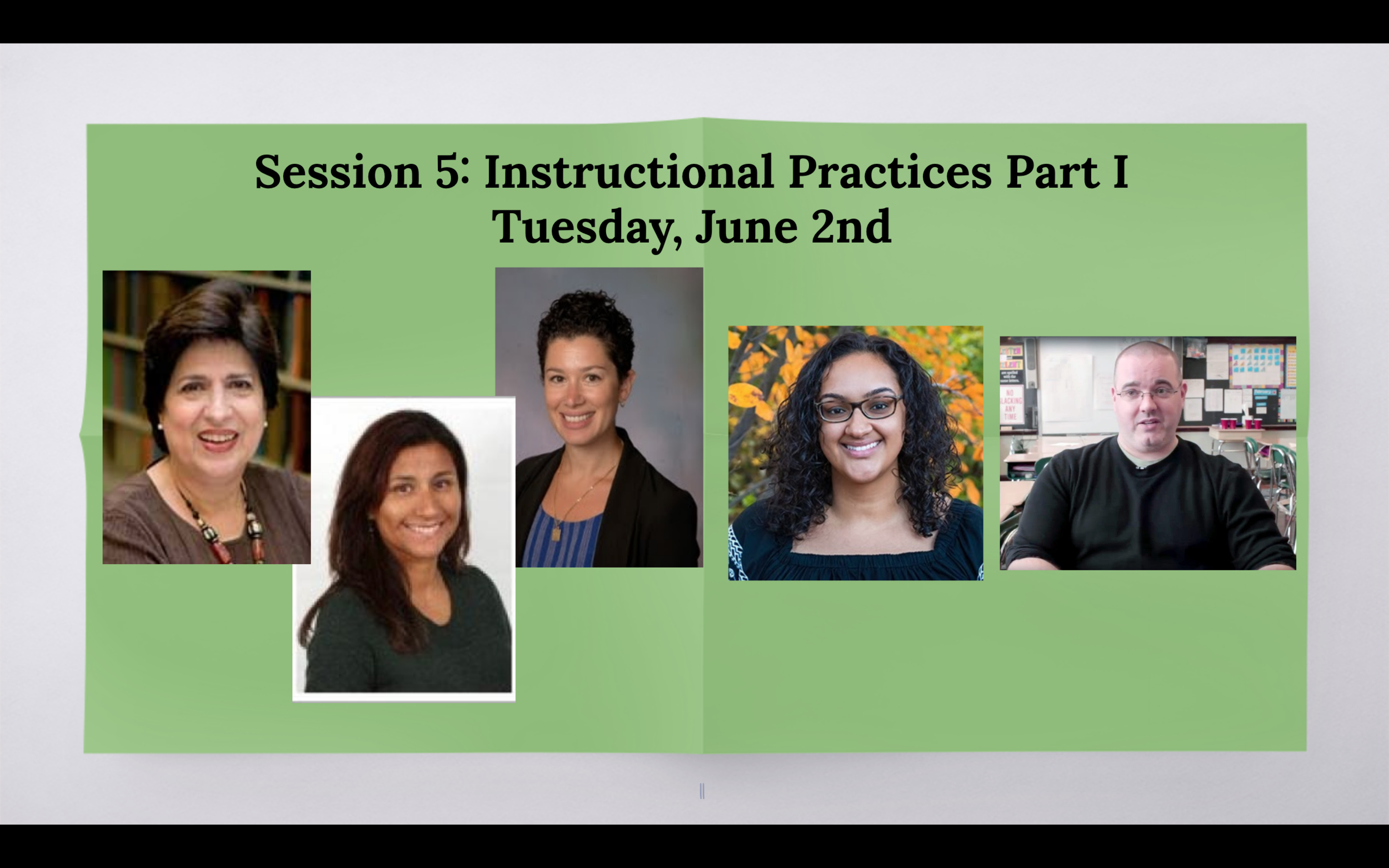
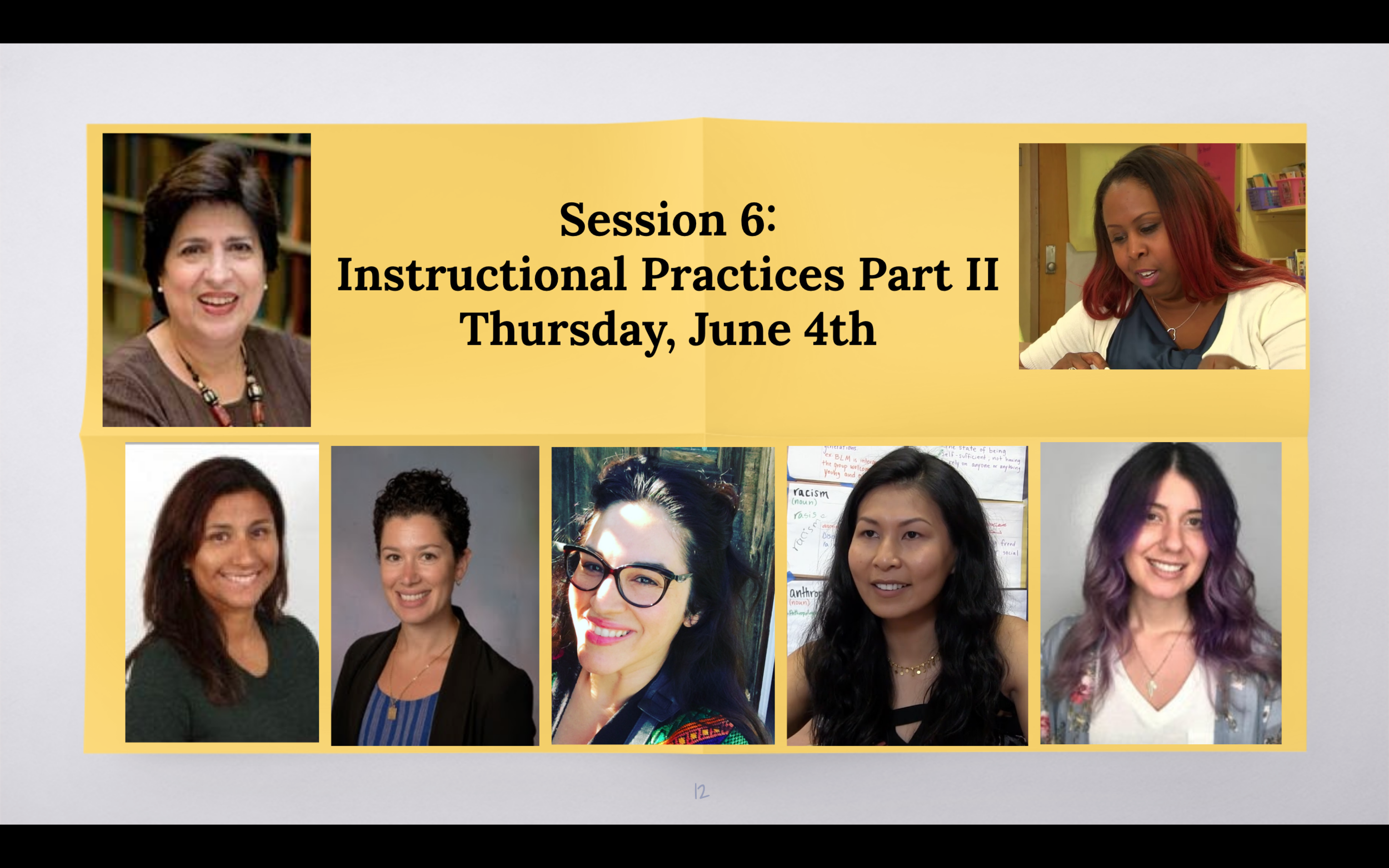
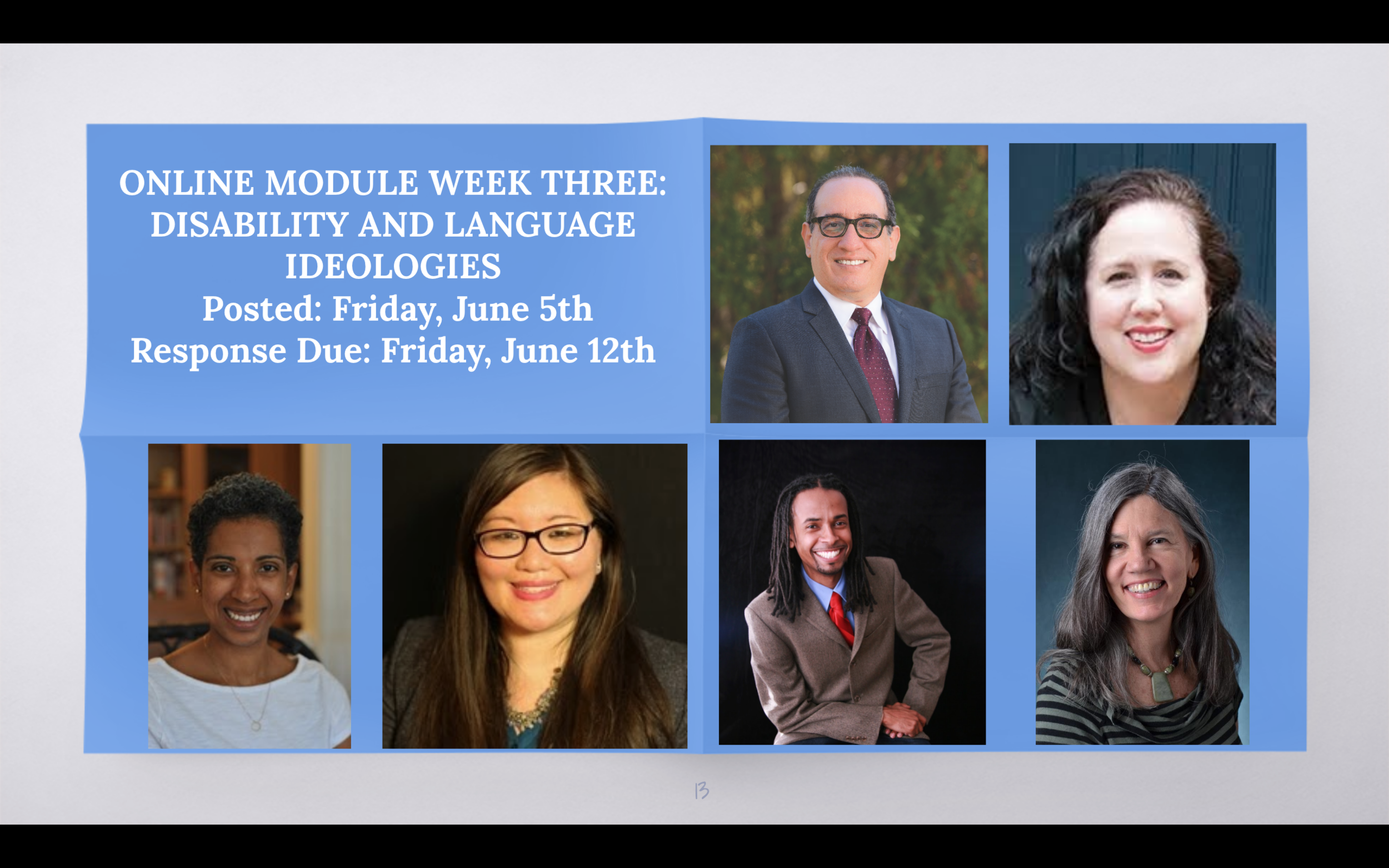
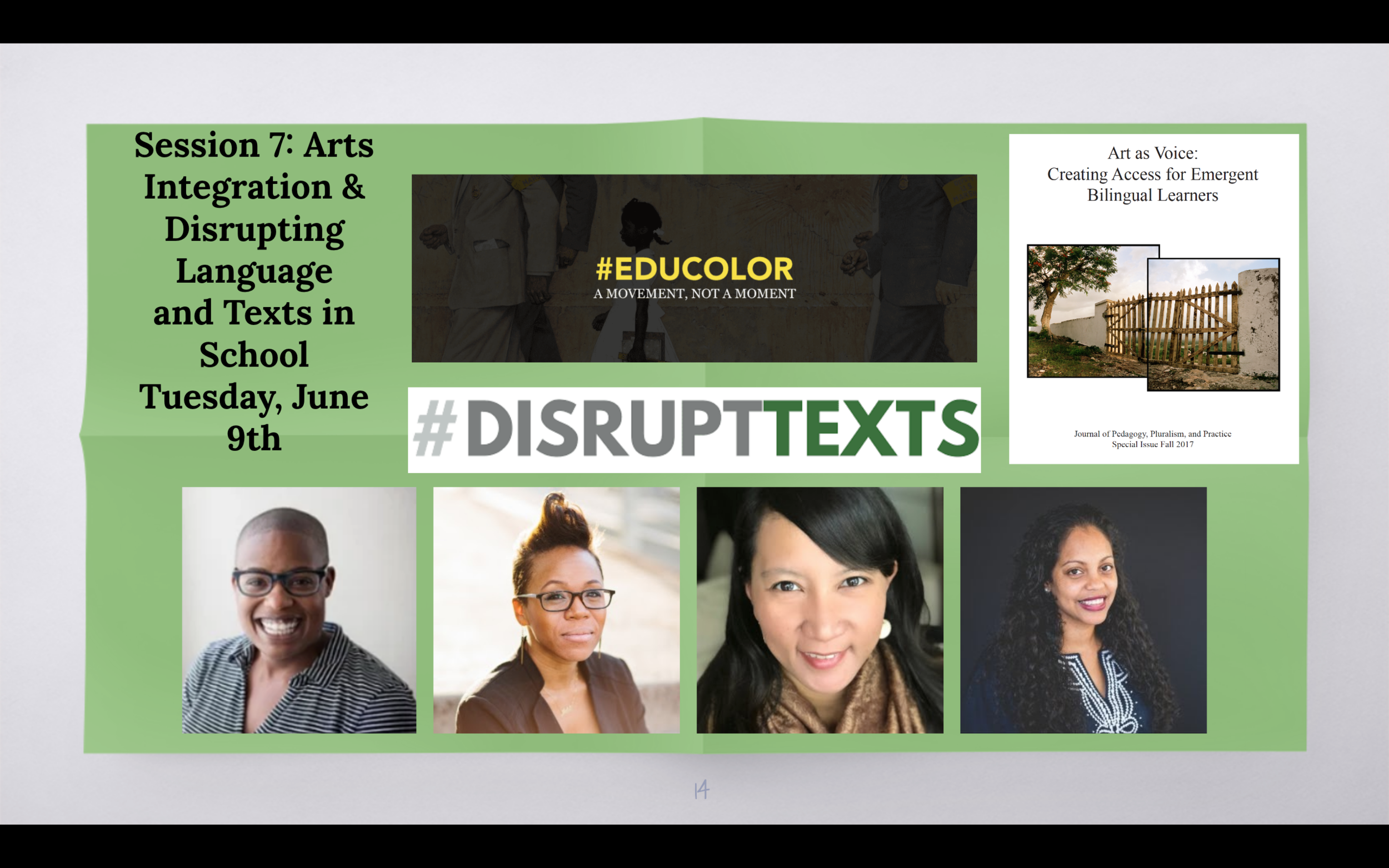

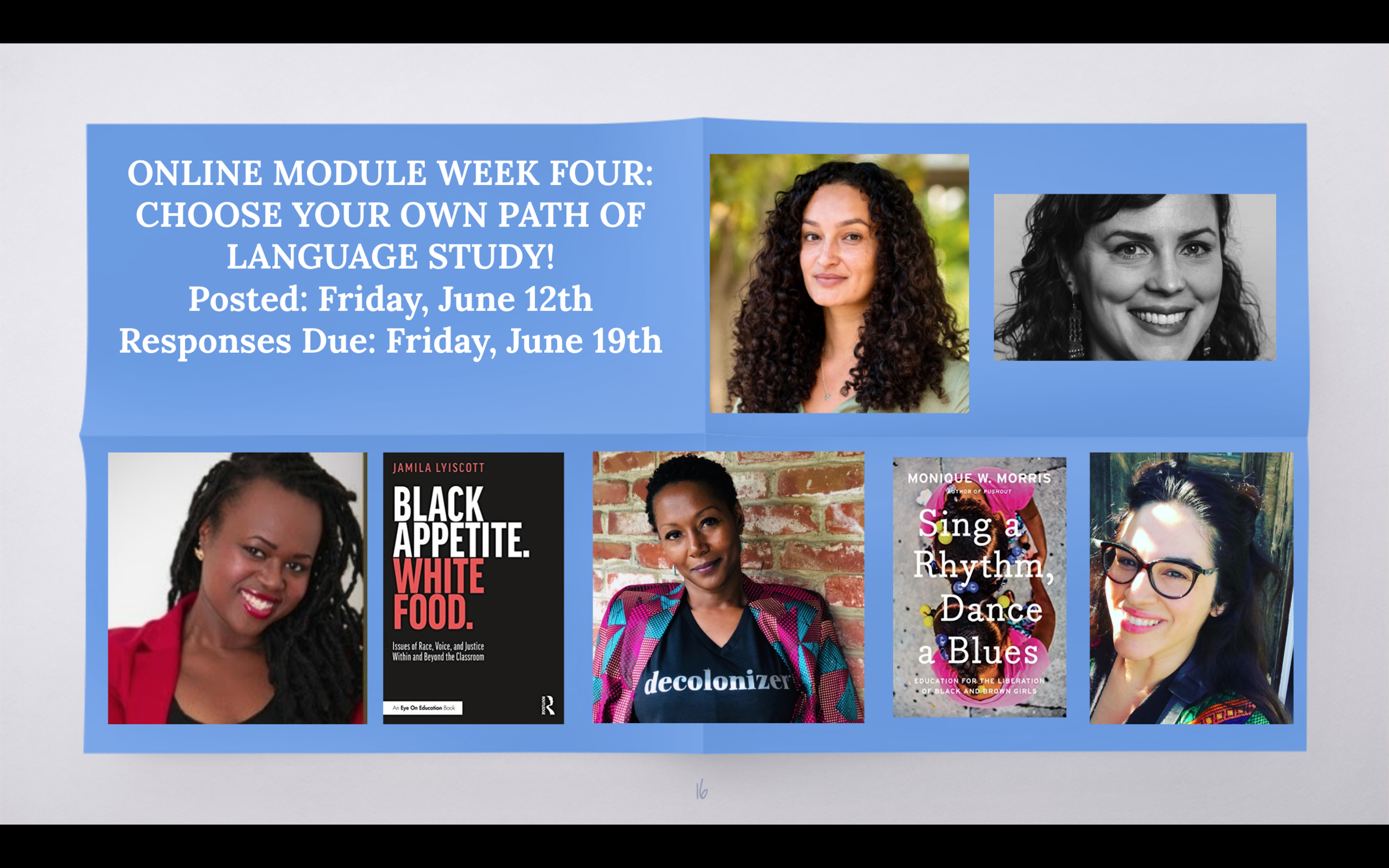
First Week of the Course*
*Will be adding overview videos for the other weeks soon! First, need to reflect on week one with students and get a sense of what needs to be revised.
References
It’s been months of conversations on this with teacher educators who have taught this course and making sure I bring in the latest research and writing on the critical frameworks we are applying in the course. Really grateful to two colleagues, Pam Jones, instructor at Bank Street, and Amía Soto-Carrión, also an instructor at Bank Street and 4th grade bilingual dual language teacher in NYC (Amía was also my former student at Hunter College, CUNY so it was super special to get her feedback on the course as she taught it).
Who we cite matters! See #CiteBlackWomen.
I continue to revisit the texts and references making sure we do this right.
Acevedo, E. [SlamFind] (2015, September 21). Afro-Latina [Video]. YouTube. https://www.youtube.com/watch?time_continue=140&v=tPx8cSGW4k8&feature=emb_logo
Anzaldúa, G. (1987). How to tame a wild tongue. In Anzaldúa, G. Borderlands/La frontera: The new Mestiza. Aunt Lute Books.
Artiles, A.J. Reenvisioning equity research: Disability identification disparities as a case in point. Educational Researcher, 48(6), pp. 325 –335. DOI: 10.3102/0013189X19871949
Ayers, C. (2018, July 2). Don’t mind the gap. [Audio podcast episode]. In Vocal fries podcast. Halftone audio. https://vocalfriespod.com/2019/10/31/dont-mind-the-gap-transcript/
Baker-Bell, A. (2020). Linguistic justice: Black language, literacy, identity, and pedagogy. Routledge.
Burton, L. (Host). (2017, August 29). The paper menagerie by Ken Liu [Audio podcast episode]. In LeVar Burton Reads. Stitcher. https://www.stitcher.com/podcast/stitcher/levar-burton-reads/e/51277610
Busch, B. (2012). The linguistic repertoire revisited. Applied Linguistics, 1-22.
CAST (2018). Universal Design for Learning Guidelines version 2.2. Retrieved from http://udlguidelines.cast.org
Cioè-Peña, M. (2017: The intersectional gap: how bilingual students in the United States are excluded from inclusion. International Journal of Inclusive Education 21(9), 906-919. https://doi.org/10.1080/13603116.2017.1296032
Cioè-Peña, M. (2020). Raciolinguistics and the education of Emergent Bilinguals Labeled as Disabled. Urban Review. https://doi.org/10.1007/s11256-020-00581-z
CUNY-NYSIEB. (2019). Our teacher leaders. https://www.cuny-nysieb.org/classroom-videos/ambassador/
de los Ríos, C. & Seltzer, K. (2018). Translating theory to practice: Exploring teachers’ raciolinguistic literacies in secondary english classrooms. English Education, 49-79.
de los Ríos, C. (2018). Toward a corridista consciousness: Learning from one transnational youth’s critical reading, writing, and performance of Mexican Corridos. Reading Research Quarterly 53(4), pp. 455-471. doi:10.1002/rrq.210
Delpit, L. (2002). No kinda sense. In L. Delpit and J. Kilgour Dowdy (Eds.), The skin that we speak: Thoughts on language and culture in the classroom (pp. 32-48). New Press.
#DisruptTexts (2020, April 18). #Disrupttexts: Dismantling and reimagining the literary canon. The Educator Collaborative. https://gathering.theeducatorcollaborative.com/opening-keynote-distrupttexts-spring-2020/
Elhillo, S. [TED-Ed] (2019, February 2). To make use of water. YouTube. https://www.youtube.com/watch?v=kfKDBlK3EwQ&list=PLJicmE8fK0Egxi0hgy5Tw-NFyLcpJ4bzJ&index=6&t=0s
España, C. & Herrera L.Y. (2020). En comunidad: Lessons for centering the voices and experiences of bilingual Latinx students. Heinemann.
Ferré, R. (2002). Coming up the archipelago. In Language Duel Poems. Vintage Books.
Flores, N. & Rosa, J. (2015). Undoing appropriateness: Raciolinguistic ideologies and language diversity in education. Harvard Educational Review, 85(2), 149-171. doi: http://dx.doi.org/10.17763/0017-8055.85.2.149
Flores, N. (2020). From academic language to language architecture: Challenging raciolinguistic ideologies in research and practice. Theory Into Practice, 59(1), 22-31.
Freeman, D.E. & Freeman, Y.S. (2011). Between worlds: Access to second language acquisition. Heinemann.
Fu, D., , Hadjioannou, X., & Zhou, X. (2019). Translanguaging for Emergent Bilinguals: Inclusive Teaching in the Linguistically Diverse Classroom. Teachers College Press.
García, O., Ibarra-Johnson, S., & Seltzer, K. (2016). The translanguaging classroom: Leveraging student bilingualism for learning. Caslon Publishing.
García, O. & Otheguy, R. (2016). Interrogating the Language Gap of Young Bilingual and Bidialectal Students. International Multilingual Research Journal. http://dx.doi.org/10.1080/19313152.2016.1258190
García, O. & Leiva, C. (2014). Theorizing and enacting translanguaging for social justice. In A. Blackledge, A. Creese (Eds.) Heteroglossia as practice and pedagogy. Educational Linguistics, vol 20, pp. 199-216. Springer, Dordrecht.
García, O. (2015). Language. In The Wiley Blackwell Encyclopedia of Race, Ethnicity, and Nationalism at Wiley Online Library. John Wiley & Sons, Ltd. Retrieved from http://onlinelibrary.wiley.com.central.ezproxy.cuny.edu:2048/doi/10.1002/97811186632
Gee, J. (2001). Identity as an analytic lens for research in education. Review of Research in Education, 99-125.
Germán, L. (2019). The anti-racist teacher: Reading instruction workbook. The Multicultural Classroom.
Gillon, C. (2020, March 31). Bilingualism is. It just is. [Audio podcast episode]. In Vocal fries podcast. Halftone audio. https://vocalfriespod.com/2020/04/10/bilingualism-is-it-just-is-transcript/
He, G. [Gabby He]. (2020, May 5). Gabby translingualism EDUC 546. [Video] YouTube. https://www.youtube.com/watch?v=iHv5N6tDXC8
Jimenez, F. (1997). Inside Out. In The circuit: Stories from the life of a migrant child. University of New Mexico Press.
Klingner, J. (2014, April). Distinguishing language acquisition from learning disabilities. Retrieved from http://gced.k12.mn.us/uploads/4/9/2/3/49230501/distinguish_language.pdf
Lankford. R. (Writer), & Braun, U.R. (Director). (July 15, 2019). Grandpa’s drum (Season one, episode one) [TV series episode]. In D. Gillim (Executive Producer), Molly of Denali. PBS Kids.
Levien, R. (Director). (2009). Immersion [Film]. Widdershins film/Don’t foam productions.
Live Nation. (2017, June 9). 102 Earthworks: Miguel: Mexico Chapter 1 [Video]. YouTube. https://www.youtube.com/watch?v=08vbGWfYFFI
Lo, A. (2016). Suddenly faced with a Chinese village: The linguistic racialization of Asian Americans. In H. S. Alim., J. R. Rickford, & A.F. Ball (Eds.), Raciolinguistics: How language shapes our ideas about race. Oxford University Press.
Lorde, A. (1984). Age, race, class, and sex: Women redefining difference. In Sister, Outsider. Crossing Press.
Lyiscott, J. (2019). Black appetite, white food: Issues of race, voice and justice within and beyond the classroom. Routledge.
Lyiscott, J. (2014, February). 3 Ways to Speak English [Video]. TED. https://www.ted.com/talks/jamila_lyiscott_3_ways_to_speak_english.
Martinez-Roldan, C. & Malave, G. (2011). Identity construction in the borderlands: The Acosta family. In V. Kinloch, Urban literacies: Critical perspectives on language, learning, and community (pp. 53-71). New York: Teachers College Press.
Mayorga, E. (Host). (2020, April 22). Political encounters: Bilingual Latinx students (33) [Audio podcast episode]. In Encuentros políticos/Political encounters. Usalamedia Radio. https://edwinmayorga.net/?p=985
Mena, M. (2019, January 31). Flores and Rosa: Undoing appropriateness: Raciolinguistic ideologies and language diversity in education (2015) [Video]. YouTube. https://www.youtube.com/watch?v=5oPWMEJjGbk
Meraji, S.M. & Demby, G. (Hosts). (2020, April 29). When Poets decide who counts [Audio podcast episode]. In Code Switch. NPR. https://www.npr.org/2020/04/22/840958430/when-poets-decide-who-counts
Morris, M. (2019). Sing a Rhythm, Dance a Blues: Education for the Liberation of Black and Brown Girls. The New Press.
NCTE. (2016). What anti-racist language teachers do. In the Committee against racism and bias in the teaching of English. NCTE.
Neal, H. & Cullinan, D. (2018). Talking Black in America [Film]. The language and life project at NC University.
Paris, D. (2016). “It was a Black city:” African American language in California’s changing urban schools and communities. In H. S. Alim., J. R. Rickford, & A.F. Ball (Eds.), Raciolinguistics: How language shapes our ideas about race. Oxford University Press.
Phuong, J. (2017). Disability and language ideologies in education policy. Working Papers in Educational Linguistics 32(1), 47-66.
Smitherman, G. (2017). “Raciolinguistics,” “mis-education,” and Language Arts teaching in the 21st century. In Language Arts Journal of Michigan: (32:2,3), 4-12.
Suina, J. (2009). And Then I Went to School. In L. Christensen (Ed.), Teaching for joy and justice: Re-imagining the Language Arts classroom (pp. 230-234). Rethinking Schools.
Tatum, B.D. (2016). The complexity of identity. In Why are all the Black kids sitting together in the cafeteria? and other conversations about race. Basic Books.
Timsit, A. (2019). The dad from that viral baby video is demonstrating a crucial parenting skill. Quartz.com. Retrieved from https://qz.com/1639907/the-viral-video-of-a-dad-talking-to-his-baby-demonstrates-a-crucial-parenting-skill/
Understood.org. (n.d.). Racial disproportionality in Special Education [Video file]. Retrieved from https://www.understood.org/en/community-events/blogs/the-inside-track/2018/05/23/f
Vogel, S. & García, P. (2017). Translanguaging. In G. Noblit & L. Moll (Eds.), Oxford research encyclopedia of education. Oxford University Press.
Wager, A. C., Poey, V.M., & Berriz, B.R. (2017). Art as voice: Creating access for emergent bilingual learners (full issue). Journal of Pedagogy, Pluralism, and Practice. 9(1), Article 1.
Woodson, J. (2014). Brown girl dreaming. Puffin Books.
Yule, G. (2016). The sound patterns of language. In The study of language (4th ed., pp. 42-54; 6th ed., pp. 42-54). Cambridge, UK: Cambridge University Press.


